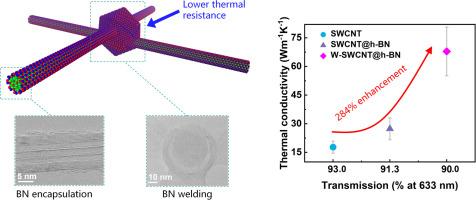Boron nitride welded and encapsulated single-wall carbon nanotube films with enhanced thermal conductivity
IF 14.3
1区 材料科学
Q1 MATERIALS SCIENCE, MULTIDISCIPLINARY
引用次数: 0
Abstract
Single-wall carbon nanotubes (SWCNTs) have attracted significant attention as a thermal management material because of their high thermal conductivity and excellent thermal stability. However, decreasing the great thermal contact resistance at the tube-tube junctions of SWCNT assemblies is a prerequisite for its practical applications. We report a strategy to address this issue by welding the junctions of SWCNTs together and introducing hexagonal boron nitride (h-BN) encapsulating layers to the surface of the SWCNT bundles. By changing the partial pressure of the BN precursor in a two-step atmospheric-pressure chemical vapor deposition process, amorphous BN nanoparticles and crystalline h-BN were deposited to weld and encapsulate the SWCNT network in sequence. The introduction of the BN led to an in-plane thermal conductivity ∼ 3.8 times higher than that of the SWCNT film, as measured by optothermal Raman method. Molecular dynamics simulations demonstrate that the BN welding and encapsulating facilitate thermal transport by reducing thermal resistance at the tube-tube junctions. Our work brings new insights into facilitating the heat transport in low-dimensional nanomaterial assemblies through structural design.

氮化硼焊接和封装的单壁碳纳米管薄膜具有增强的导热性
单壁碳纳米管(SWCNTs)由于其高导热性和优异的热稳定性,作为一种热管理材料受到了广泛关注。然而,降低swcnts组件管-管交界处的巨大热接触电阻是其实际应用的先决条件。我们报告了一种解决这一问题的策略,即将SWCNTs的连接处焊接在一起,并在SWCNTs束的表面引入六方氮化硼(h-BN)封装层。在两步常压化学气相沉积工艺中,通过改变BN前驱体的分压,沉积了非晶BN纳米颗粒和结晶h-BN,并依次焊接和封装了swcnts网络。通过光热拉曼方法测量,BN的引入导致其面内导热系数比swcnts膜高~ 3.8倍。分子动力学模拟表明,氮化硼焊接和包封通过降低管-管交界处的热阻来促进热传递。我们的工作为通过结构设计促进低维纳米材料组件的热传递带来了新的见解。
本文章由计算机程序翻译,如有差异,请以英文原文为准。
求助全文
约1分钟内获得全文
求助全文
来源期刊

Journal of Materials Science & Technology
工程技术-材料科学:综合
CiteScore
20.00
自引率
11.00%
发文量
995
审稿时长
13 days
期刊介绍:
Journal of Materials Science & Technology strives to promote global collaboration in the field of materials science and technology. It primarily publishes original research papers, invited review articles, letters, research notes, and summaries of scientific achievements. The journal covers a wide range of materials science and technology topics, including metallic materials, inorganic nonmetallic materials, and composite materials.
 求助内容:
求助内容: 应助结果提醒方式:
应助结果提醒方式:


